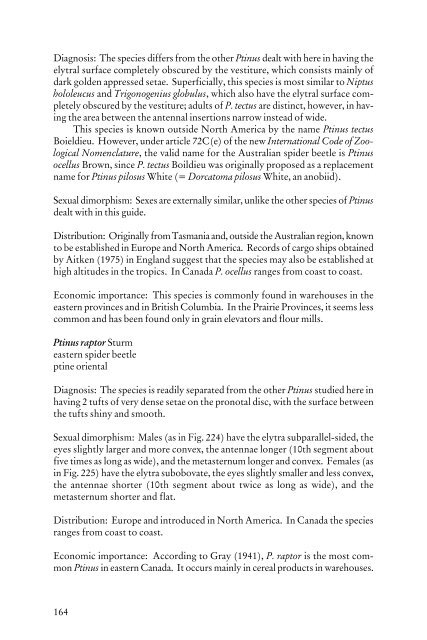Beetles Identification Guide
Beetles Identification Guide
Beetles Identification Guide
Create successful ePaper yourself
Turn your PDF publications into a flip-book with our unique Google optimized e-Paper software.
Diagnosis: The species differs from the other Ptinus dealt with here in having the<br />
elytral surface completely obscured by the vestiture, which consists mainly of<br />
dark golden appressed setae. Superficially, this species is most similar to Niptus<br />
hololeucus and Trigonogenius globulus, which also have the elytral surface completely<br />
obscured by the vestiture; adults of P. tectus are distinct, however, in having<br />
the area between the antennal insertions narrow instead of wide.<br />
This species is known outside North America by the name Ptinus tectus<br />
Boieldieu. However, under article 72C(e) of the new International Code of Zoological<br />
Nomenclature, the valid name for the Australian spider beetle is Ptinus<br />
ocellus Brown, since P. tectus Boildieu was originally proposed as a replacement<br />
name for Ptinus pilosus White (= Dorcatoma pilosus White, an anobiid).<br />
Sexual dimorphism: Sexes are externally similar, unlike the other species of Ptinus<br />
dealt with in this guide.<br />
Distribution: Originally from Tasmania and, outside the Australian region, known<br />
to be established in Europe and North America. Records of cargo ships obtained<br />
by Aitken (1975) in England suggest that the species may also be established at<br />
high altitudes in the tropics. In Canada P. ocellus ranges from coast to coast.<br />
Economic importance: This species is commonly found in warehouses in the<br />
eastern provinces and in British Columbia. In the Prairie Provinces, it seems less<br />
common and has been found only in grain elevators and flour mills.<br />
Ptinus raptor Sturm<br />
eastern spider beetle<br />
ptine oriental<br />
Diagnosis: The species is readily separated from the other Ptinus studied here in<br />
having 2 tufts of very dense setae on the pronotal disc, with the surface between<br />
the tufts shiny and smooth.<br />
Sexual dimorphism: Males (as in Fig. 224) have the elytra subparallel-sided, the<br />
eyes slightly larger and more convex, the antennae longer (10th segment about<br />
five times as long as wide), and the metasternum longer and convex. Females (as<br />
in Fig. 225) have the elytra subobovate, the eyes slightly smaller and less convex,<br />
the antennae shorter (10th segment about twice as long as wide), and the<br />
metasternum shorter and flat.<br />
Distribution: Europe and introduced in North America. In Canada the species<br />
ranges from coast to coast.<br />
Economic importance: According to Gray (1941), P. raptor is the most common<br />
Ptinus in eastern Canada. It occurs mainly in cereal products in warehouses.<br />
164
















